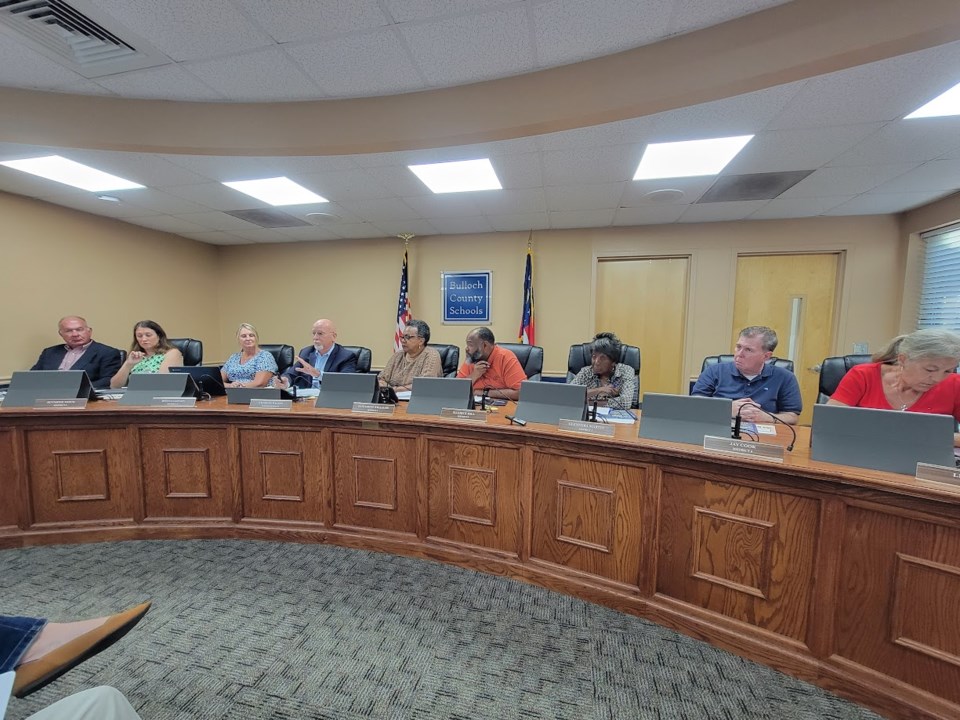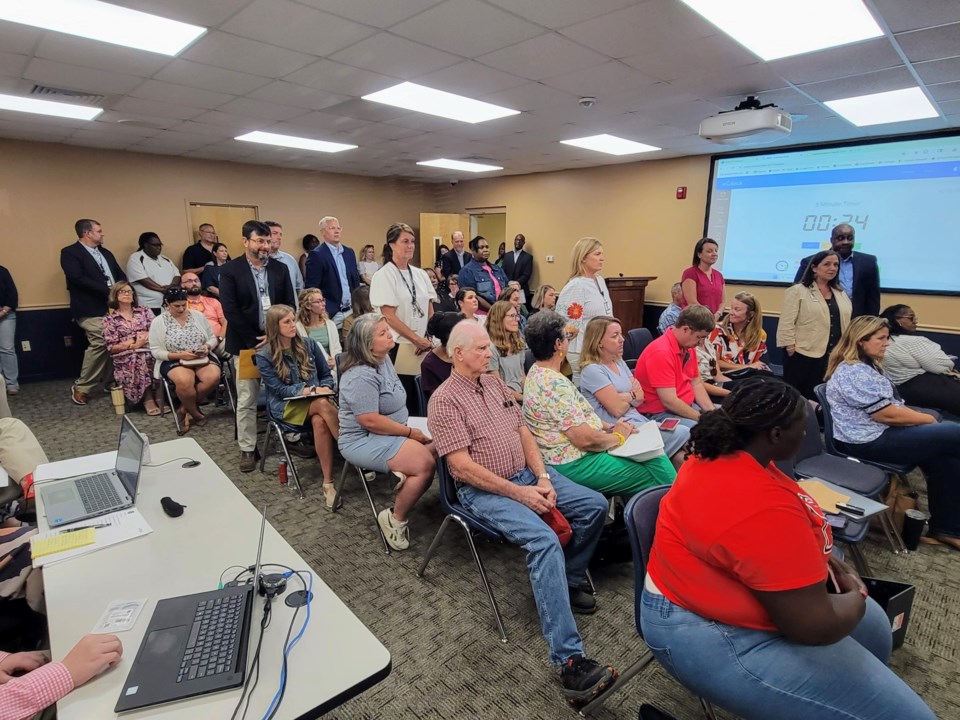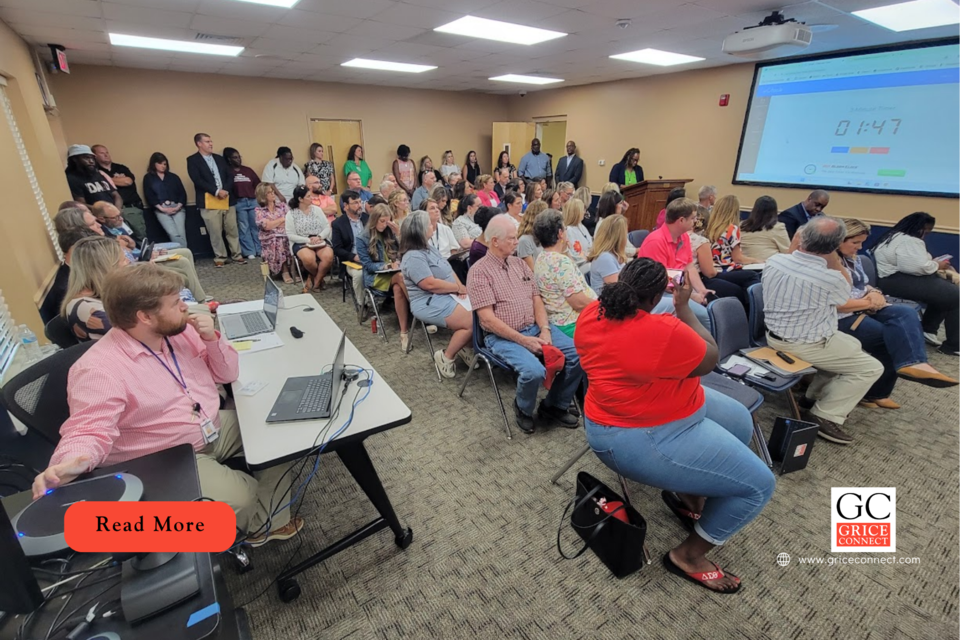The Bulloch County Board of Education (BOE) convened on Thursday evening July 24, 2025 in front of a standing room only crowd for a crucial budget presentation, where Superintendent Charles Wilson laid bare a projected $15 million deficit for Fiscal Year 2027. Wilson outlined the contributing factors to this substantial shortfall and presented the board with two stark options: a significant reduction in force (RIF) and program cuts, or an increase in the local millage rate.
Unpacking the Deficit: A Cascade of Challenges
Superintendent Wilson clarified that the projected $4 million deficit for the current fiscal year (FY26), which was anticipated to balance out in FY27, has escalated dramatically due to a confluence of unforeseen financial pressures. He attributed the rise from $4 million to $13.2 million (carrying into the $15 million projection for FY27) to several key factors:
- Revenue Losses: A local decision to implement House Bill 581, offering tax relief for homeowners, is estimated to reduce local property tax collections to Bulloch Schools by approximately $1 million.
- State Funding Changes: Shifts in the state's QBE funding formula, particularly related to property tax digest wealth and the "local five mill share" equalization component, have resulted in a significant $7.9 million loss in state funding for the district this year.
- Increased Operating Costs: Substantial increases in the Teachers Retirement System contribution rate and state health benefit plan costs have placed a heavy burden on the district. Wilson emphasized that while the state assists with some of these, many locally funded positions, including half of all certified employees, are not fully covered by state funds.
- Local Commitments: Decisions made by the district to enhance school safety by adding School Resource Officers (SROs) in all schools (estimated at $0.3 million to $0.8 million this year) and increasing athletic coaching supplements by half a million dollars have added to expenditures. (There are not additional coaching staff in the budget. What is in the budget is a $0.5M increase to fund increases to athletic supplements for middle and high school coaches. This was recommended after an extensive study of Bulloch Schools supplements compared to other similar sized districts in the state and surrounding counties. All head coaches are educators and assistant coaches are employees or lay coaches. Coaches are paid a supplement for the investment of their time in coaching an extracurricular sport.)
- Millage Rate Rollbacks: The district has continuously rolled back its property tax millage rate, further compressing available funds.
Wilson described the cumulative effect of these factors as a "domino effect" leading to the projected $15 million deficit, stressing that salaries and benefits constitute 88% of the general fund expenditures.
Click here to view Superintendent Wilson's full presentation slide deck.

Board Members Weigh In: Prioritizing Students Amidst Tough Choices
Bulloch Board of Education members expressed their appreciation for community involvement and acknowledged the difficult position the district faces. Several emphasized their primary focus: the children of Bulloch County.
Donna Clifton, a retired principal stated, "I want the reductions in our budget not to affect our children, because they're our number one priority." They advocated for reducing non-instructional staff, departmental budget cuts, or a modest millage rate increase of "one or two mills" before impacting classroom teachers.
Elizabeth Williams, a retired principal and Board Chair reflected on the potential for "devastating" consequences for children if significant teacher positions are cut. Williams explicitly stated support for decisions that would save teachers and voiced opposition to eliminating programs like TLC, questioning where students violating the code of conduct would go. Williams also researched the historical millage rate, noting it was 10.4 mills in 2012, suggesting the current low rate is "at the expense of our teachers and our children."
The idea of a combination approach was also floated, looking at reducing programs, ensuring program effectiveness, and examining teacher allocations across schools, while ultimately striving to maintain the district's high standards.
Lannie Lanier highlighted the suddenness of the revenue losses, emphasizing the $9 million hit from House Bill 581 and state funding changes, coupled with increased employee health insurance and retirement costs. They acknowledged the "balancing act" required to represent students, employees, and taxpayers.
The board members collectively thanked the public for their feedback, encouraging continued communication throughout the process to gain diverse perspectives on how to navigate this complex financial challenge.
Community Voices Ring Out at BOE Meeting: Calls to Protect Students and Staff Amidst Budget Crisis
During the Bulloch County Board of Education (BOE) meeting, several community members offered impassioned public comments regarding the district's looming $15 million budget deficit. Their remarks underscored a collective plea to prioritize student well-being and staff stability, urging the board to consider alternatives to drastic cuts.
Tracy Hartwell: The Story of "Malik" and the Safety Net
Tracy Hartwell, a district special education instructional coach, shared "Malik's Story" to illustrate the vital role that district support staff play in the lives of vulnerable students. Malik, a sixth-grader facing significant personal challenges, benefits from a web of support, including a coached ELA teacher, targeted reading intervention from an RTI coach, an MTSS team for behavioral support, and weekly sessions to manage emotions.
Hartwell painted a stark picture of what Malik's day would look like without these interventions: "Without coaching, Malik's teacher would struggle to differentiate her instruction... Malik is no longer pulled for reading intervention, so his difficulties go unnoticed... Without his MTSS team, there's no coordinated meeting... he's labeled the problem kid... Without his weekly sessions... he lashes out and he's suspended." She concluded by stating that eliminating these positions would "derail Malik's dreams and other students" who rely on these services, emphasizing that students in high-poverty schools need more support, not less.
Stacy Reece: An Investment, Not a Burden
Stacy Reece, a 25-year district employee, parent, and taxpayer, spoke with "a place of deep and profound love... for our school district, community, and most of all our kids." Reese challenged the board to view schools as "an investment, not a burden, not a line item." She voiced concerns for those "afraid to speak" and presented the budget deficit as a "values decision" rather than just a financial one.
Reese urged the board to "protect people who build those relationships with students every single day" and to avoid decisions that cause "long-term damage just to survive short." She implored the board to look beyond spreadsheets to the "faces of kids who count on adults to show up for them." Her powerful message advocated for "real solutions," specifically urging the board to raise the millage rate. Reese warned that if 125 positions are eliminated, "they won't come back. New teachers and staff won't come either. Not if we send a message that they are disposable." She concluded by stating, "Our kids are watching, and I hope that's making" the board's decision.
Michele Martin: Learning from Past Mistakes and Long-Term Investment
Michele Martin, a parent of two students, echoed the concerns about funding cuts and position eliminations, stressing that such decisions "will go far beyond the schoolhouse and affect the long-term well-being of our children and the community." She drew parallels to the "Great Recession," where budget cuts led to "lower test scores, college enrollment declined, and achievement gaps widened."
Martin emphasized that cuts to the teacher workforce are "the single most damaging choice ever to make," leading to "deep, generational losses." She argued that Bulloch County, as a "growing community with expanding mobile revenues," has options. She advocated for an increase in the millage rate as a "small adjustment" that could "stabilize our schools without devastating the people and programs our students rely on every day." Martin's plea was clear: "Do not make our children pay for our budget shortfalls that they didn't create. Let us not repeat mistakes of the past."

Difficult Choices: RIFs and Program Cuts vs. Millage Rate Increase
With the vast majority of the budget tied to personnel, Superintendent Wilson stated that addressing a deficit of this magnitude would primarily impact salaries and benefits. He detailed the immediate actions being taken and the difficult decisions facing the board:
- Immediate Staff Reductions: Ten-and-a-half district support personnel positions have already been notified of elimination for FY27.
- Program Eliminations: The TLC (Transition Learning Center) director and the Life Program coordinator have been informed that both programs will be eliminated in FY27. Wilson asserted that these were superintendent decisions aimed at reaching the necessary budget reductions at the district level before directly impacting classrooms.
- School-Level Reductions: After district-level cuts, the remaining portion of the $15 million reduction will necessitate a projected 25% reduction in school allocations, which would directly translate to a significant number of positions. Wilson estimated this could affect around 125 teaching jobs, though the precise number could vary.
As an alternative to these drastic cuts, the discussion turned to the possibility of raising the millage rate. While the district intends to roll back the millage from 7.932 mills to 7.446 mills in the coming weeks, board members inquired about the impact of increasing it instead. Wilson explained that each mill generates approximately $3.8 million in revenue. He suggested that returning the millage rate to the Fiscal Year 2012 level of 10.4 mills would significantly alleviate the need for many of the proposed cuts, though some reductions would likely still be necessary. Such an increase would impact tax bills starting this fall.
1 mill increase amounts to around $100 based on the average home value in Bulloch County of $250,000. Three mills would bring this to an average annual increase of $300.
Urgent Deliberation and Community Impact
The board acknowledged the gravity of the situation, with several members expressing reluctance to reverse previously approved budget plans that included a millage rollback. However, Superintendent Wilson emphasized the immediate need for a decision, stating that waiting would only exacerbate the problem and lead to greater uncertainty for employees and the community. He warned against "kicking the can down the road" and stressed the superintendent's responsibility to prevent a "hard concrete nosedive, financially."
Ultimately, the board reached a consensus to hold a special called meeting early next week to specifically discuss the millage rate. The purpose of this meeting will be to set a tentative millage rate, with the understanding that a decision on whether to raise taxes or proceed with significant staff and program cuts is imminent. The meeting will be open to the public and media.
Grice Connect will update this story with the meeting information once it has been set. We will also place it on our events calendar.
The Bulloch County Schools teachers, staff and community now awaits the outcome of these critical deliberations, as the board navigates the challenging path to balance the budget while striving to minimize the impact on students and staff.




